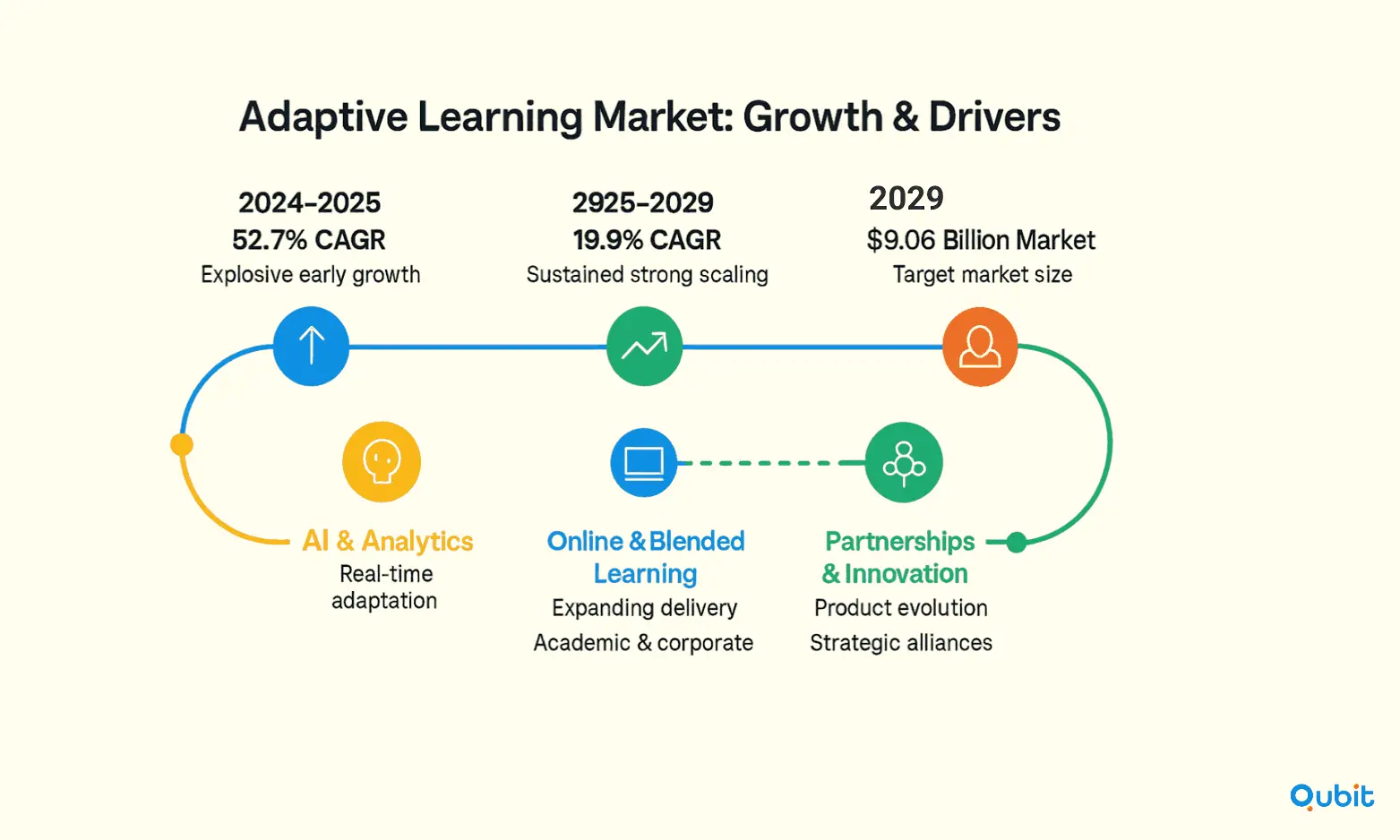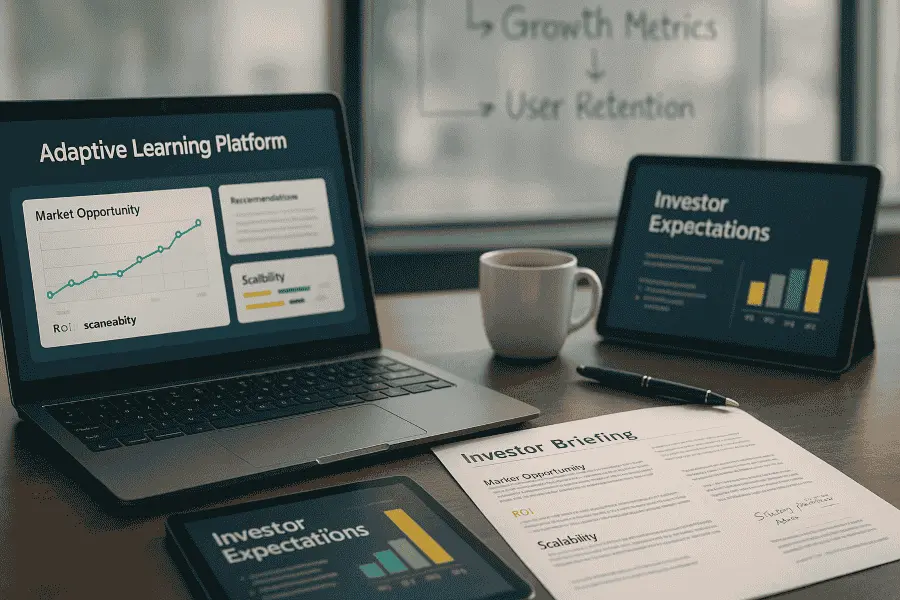The adaptive learning platform market is evolving at breakneck speed, propelled by AI, data analytics, and a global push for personalized education. For founders and product leaders, understanding what investors look for in this dynamic sector is no longer optional, it’s essential. As the market grows from $2.87 billion in 2024 to a projected $4.39 billion in 2025, and further to $9.09 billion by 2029, investor scrutiny is intensifying.
This article unpacks the key expectations investors have for adaptive learning startups, offering actionable insights and real-world examples to help you stand out in a crowded field.
The Adaptive Learning Market: Growth and Opportunity

The numbers tell a compelling story. The global adaptive learning market is projected to grow at a CAGR of 52.7% from 2024 to 2025, then maintain a robust 19.9% CAGR through 2029, reaching $9.06 billion. This surge is driven by several factors:
- Rising demand for personalized education and tailored learning experiences.
- Integration of AI and data analytics for real-time content adaptation.
- Expansion of online and blended learning in both academic and corporate settings.
- Strategic partnerships and technological innovation fueling rapid product evolution.
Academic institutions remain the largest end users, but corporate training and lifelong learning are emerging as high-growth segments. Investors are tracking these trends closely, seeking platforms that address both current market needs and future opportunities.
What Makes Adaptive Learning Platforms Attractive to Investors?
Investors are drawn to adaptive learning for its potential to disrupt traditional education and training. But their expectations are specific and rising. Here’s what they want to see:
1. Demonstrable Impact on Learning Outcomes
Investors expect clear, data-backed evidence that your platform improves learning. McKinsey’s research shows individualized learning paths can boost student engagement by up to 60% and improve educational results by 30%. Platforms must move beyond anecdotal success and show:
- Quantifiable improvements in test scores, retention, or skill mastery.
- Robust analytics that track learner progress and adapt content in real time.
- Published case studies or pilot results with credible third-party validation.
2. Scalability and Flexibility
The ability to scale across student populations, geographies, and use cases is non-negotiable. Investors want platforms that:
- Leverage cloud-based infrastructure for cost-effective, global deployment.
- Support multiple learning levels (K-12, higher ed, corporate) and languages.
- Integrate easily with existing Learning Management Systems (LMS) and school IT environments.
3. Advanced Technology and AI Integration
Adaptive learning’s core value comes from its technology. Investors are prioritizing:
- Proprietary AI or machine learning algorithms.
- Continuous innovation—regular updates, new features, and the ability to incorporate emerging tools like AR/VR or advanced analytics.
- Data privacy and security as table stakes, not afterthoughts.
4. Strong Business Model and Revenue Predictability
With the market maturing, investors seek clear paths to profitability. The most attractive platforms:
- Use subscription, licensing, or usage-based models for predictable recurring revenue.
- Demonstrate high retention rates and low customer churn.
- Show diversified customer bases (schools, districts, enterprises, direct-to-consumer).
Every funding route has its own trade-offs, Funding Models for Personalized Learning EdTech Startups. lays out which approaches suit different stages and goals
5. Market Differentiation and Competitive Moat
The adaptive learning space is crowded and getting more so. Investors want to know:
- What sets your platform apart? (e.g., unique content partnerships, superior UX, niche focus)
- How defensible is your technology? (patents, proprietary data, exclusive integrations)
- What’s your go-to-market strategy? (direct sales, channel partnerships, freemium-to-paid conversion)
6. Visionary but Pragmatic Leadership
Investors back teams, not just products. They look for:
- Founders with domain expertise in education, AI, or both.
- Ability to attract and retain top talent in engineering, pedagogy, and sales.
- A track record of execution—meeting milestones, adapting to feedback, and navigating regulatory hurdles.
Key Trends Shaping Investor Expectations
AI and Data-Driven Personalization
AI is the engine behind adaptive learning. Investors expect platforms to:
- Leverage real-time data to adjust content, pacing, and feedback for each learner.
- Offer actionable insights for educators and administrators.
- Continuously improve algorithms based on user behavior and outcomes.
Mobile and Cloud-First Solutions
The shift to mobile and cloud-based learning is accelerating. Investors favor platforms that:
- Are device-agnostic and accessible on smartphones, tablets, and laptops.
- Use cloud infrastructure for scalability and lower total cost of ownership.
- Support offline learning for regions with inconsistent internet access.
Accessibility and Inclusivity
Adaptive learning is expected to close—not widen—achievement gaps. Investors increasingly demand:
- Compliance with accessibility standards (e.g., WCAG, ADA).
- Support for diverse learners, including language options, differentiated instruction, and tools for students with disabilities.
- Evidence of impact in underserved or marginalized communities.
Integration with Emerging Technologies
Platforms that experiment with or deploy AR/VR, gamification, and social learning features are seen as forward-thinking. Investors want to see:
- Pilot projects or partnerships with hardware and content providers.
- Early data on engagement and outcomes from these innovations.
Market Segmentation and Growth Hotspots
The adaptive learning market is segmented by:
- Component: Platform vs. Services (consulting, implementation, support).
- Deployment: Cloud vs. On-premise (cloud is growing fastest).
- End User: Academic (K-12, higher ed) vs. Enterprise (corporate training).
Academic institutions still dominate, but enterprise training is a rapidly growing segment, especially as companies invest in upskilling and reskilling employees for the digital economy.
What Investors Want to See in Your Pitch
1. Compelling Problem and Solution Fit
- Clear articulation of the educational or training challenge you address.
- Evidence that your adaptive approach outperforms traditional or static e-learning.
2. Robust Technology and Product Roadmap
- Demonstrable AI and analytics capabilities.
- Plans for ongoing innovation and feature expansion.
- Commitment to data privacy, security, and compliance.
3. Traction and Validation
- User growth, engagement metrics, and retention rates.
- Testimonials, case studies, or published research.
- Letters of intent or contracts with schools, districts, or enterprises.
4. Go-to-Market Strategy
- Defined sales channels (direct, partners, online).
- Customer acquisition cost (CAC) and lifetime value (LTV) projections.
- Pilot programs or partnerships that can be scaled.
5. Financial Discipline
- Realistic revenue projections and burn rate.
- Pathways to profitability, not just growth.
- Sensitivity to pricing, especially in price-sensitive education markets.
Knowing where and when to pitch makes all the difference, How to Raise Funds for EdTech Startups: Opportunities and Challenges walks you through each phase so you can sidestep the common missteps.
Red Flags That Turn Investors Away
- Lack of measurable impact: Vague claims without supporting data.
- Overreliance on buzzwords: AI, blockchain, or gamification with no clear value add.
- Weak go-to-market plan: No clear path to customers or sustainable revenue.
- Ignoring compliance: No plan for data privacy, accessibility, or educational standards.
- Single-market focus: Platforms limited to one region or demographic without plans for expansion.
Real-World Examples: What’s Getting Funded
- DreamBox Learning: Leveraged proprietary adaptive technology and strong evidence of impact to secure multiple funding rounds.
- McGraw-Hill’s ALEKS: Built a defensible moat with patented algorithms and deep integration into school curricula.
- SAS Adaptive Learning: Focused on enterprise and higher education, showing adaptability beyond K-12.
These platforms combined robust technology, proven outcomes, and scalable business models, exactly what investors want.
Building Investor Trust: Best Practices
- Transparency: Share both wins and setbacks. Investors appreciate honesty.
- Data-driven storytelling: Use metrics, not just narratives, to make your case.
- Continuous improvement: Show how user feedback and learning analytics drive your roadmap.
- Strategic partnerships: Highlight collaborations with content providers, tech firms, or educational institutions.
The Road Ahead: Future Investor Expectations
As the adaptive learning market matures, expect investors to demand:
- Greater evidence of long-term learning gains and career impact.
- Integration with workforce development and credentialing systems.
- Stronger focus on ethical AI, transparency, bias mitigation, and explainability.
- Global scalability, not just language support, but cultural adaptation.
- Sustainable impact, balancing profitability with educational equity.
Investors are leaning into tailored learning solutions, How Personalized Learning Technology Drives EdTech Funding highlights the trends and success stories that are turning heads.
Conclusion
Investor expectations for adaptive learning platforms are rising as the market accelerates toward $9 billion by 2029. Founders must be ready to prove impact, scalability, and technological edge—while demonstrating a clear business case and a commitment to accessibility. The most successful platforms will combine visionary leadership with data-driven execution, leveraging partnerships and continuous innovation to stay ahead.
If you need to translate efficacy studies, MTSS alignment, and accessibility compliance into an investable case, we stitch narrative to numbers. Engage our edtech fundraising assistance. Request an investor-fit roadmap!
Key Takeaways
- The global adaptive learning market is projected to reach $9.06 billion by 2029, growing at nearly 20% CAGR.
- Investors prioritize platforms with proven, data-driven improvements in learning outcomes and student engagement.
- Scalable, AI-powered technology and seamless integration with existing educational systems are critical for attracting investment.
- K-12 and higher education remain the largest end-user segments, but corporate training is a fast-growing opportunity.
- North America leads the market with over 37.5% share in 2024, driven by early tech adoption and strong EdTech investment.
- Partnerships, M&A activity, and expansion into emerging markets are fueling further growth and innovation in the sector.
Frequently asked Questions
What is driving the growth of adaptive learning platforms?
Rising demand for personalized education, advancements in AI and machine learning, and the shift toward online and blended learning models are key growth drivers






